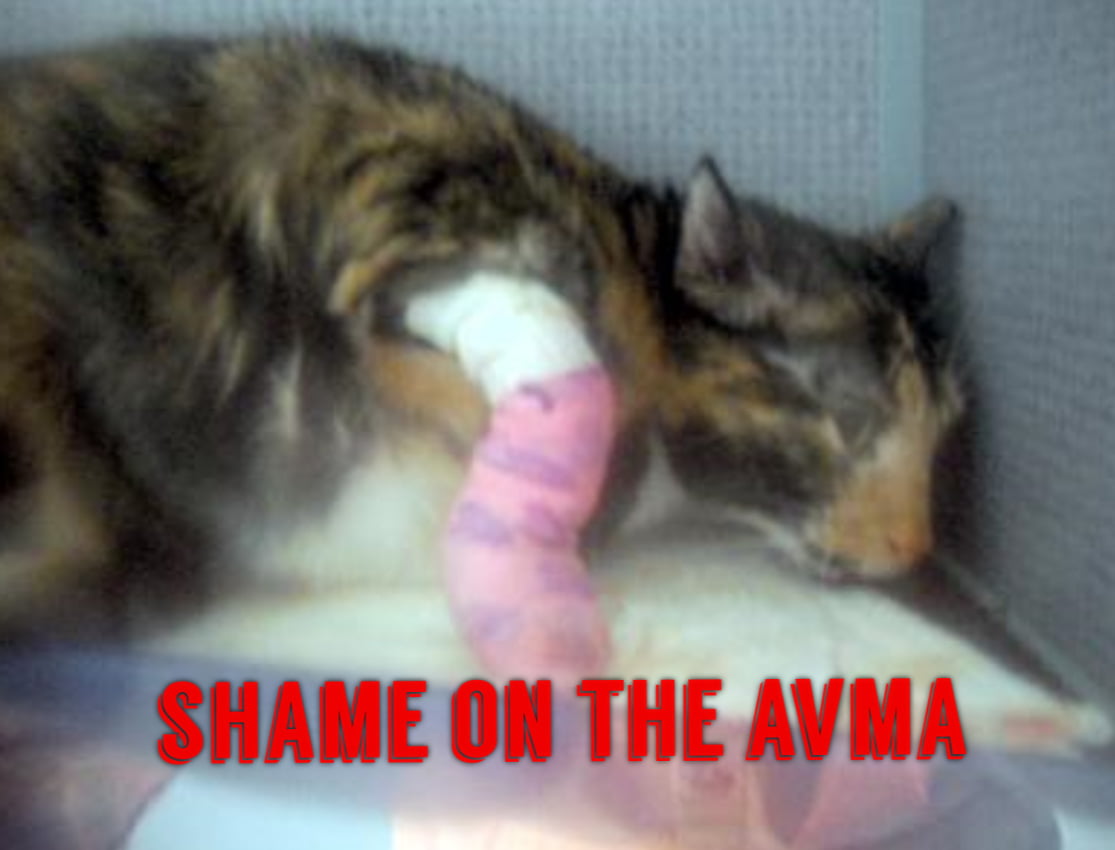Canadian veterinarians have shamed American veterinarians by issuing a firm statement through their association, the Canadian Veterinary Medical Association, that they oppose the declawing of cats. It is an unqualified statement unlike that made by the AVMA which leaves the door open to declawing for non-therapeutic reasons because they leave the decision-making in the hands of unscrupulous veterinarians.

Their position statement is:
“The Canadian Veterinary Medical Association (CVMA) opposes elective and non-therapeutic Partial Digital Amputation (PDA), commonly known as declawing or onychectomy, of domestic cats.”
The CVMA’s unequivocal stance against declawing shames the veterinarians of America who hang onto this barbaric mutilation of domestic cats having lost all credibility in their justifications for doing it.
The CVMA regard non-therapeutic declawing as ethically unacceptable “when performed without comprehensive client education including a thorough review of available alternatives”.
There is a heavy stress on educating cat owners. And there is a stress to on the need for veterinarians to go over available alternatives. They state that “the surgery has the potential to cause unnecessary and avoidable pain and alternatives to PDA are available”.
The CVMA also make the strong statement that “veterinarians should educate clients about strategies that provide alternatives to PDA”. They place an obligation upon their veterinarians to educate their cat owning clients. This is simply something that American veterinarians often do not do. Many American veterinarians dress up the declawing operation with euphemistic statements and discount services. It is quite objectionable to any decent minded person.
It is truly time for the American veterinarians to change their attitude towards declawing and follow the lead set by their neighbors.
The revised Canadian Veterinary Medical Association’s oath includes the following statement “prevent and relieve animal suffering”. Declawing achieves the opposite.
They restate (and I think it needs restating) that scratching is a normal feline behavior. A cat’s claws are an essential part of the domestic cat’s anatomy. The CVMA admit that non-therapeutic PDA is normally performed for the convenience of the owner. It is not the job of a veterinarian to carry out substantial amputations simply for the owner’s convenience. That obviously goes without saying and yet it happens millions of times every year in America.
The CVMA view cat declawing as unacceptable because “it offers no advantage to the feline and the lack of scientific evidence leaves us unable to predict the likelihood of long-term behavioral and physical negative side effects”. Note: There are considerable complications from declawing and a substantial number of the operations are badly carried out.
The association also says that the surgical amputation of the third phalanx of the digit “alters the expression of normal behaviors in cats, causes avoidable short-term acute pain, and has the potential to cause chronic pain and negative long-term orthopedic consequences”.
The association also says that as the third phalanx is removed by declawing cats must bear their weight on the second phalanx. This can result in lameness. They admit that lameness in cats is difficult to diagnose and detect and for this reason the “long-term orthopedic effects of PDA are poorly understood”.
The CVMA refer to a recent long-term study which assessed cats six months after declawing. The study found no significant differences between cats that had been declawed those that hadn’t. However, they imply that the study is flawed because it only considered cats with successful surgical outcomes. Therefore the study has limited application and “generalizability”. As mentioned above, many declawing operations do not have successful outcomes and many are blotched.
Another point that the CVMA make is that when a cat is an acute pain because of declawing they may engage in what humans call “inappropriate elimination”. This is because the cat litter is too painful to bear on the damage paws. Domestic cats who have been declawed may also demonstrate increased aggression and excessive vocalization (they may bite and they may cry out more often). Perhaps they are crying with pain.
Frequently, the AVMA say that declawing is necessary to protect people with weakened immune systems. The CVMA counter this argument by saying that the US Center for Disease Control and Prevention does not list PDA as a means of preventing disease in either healthy or immunocompromised individuals.
Another argument that the AVMA wheel out in defence of declawing is that it stops people relinquishing cats to shelters. The counterargument from the CVMA is that there are no current peer-reviewed studies which support a higher rate of relinquishment of cat with intact claws versus cats those that have undergone PDA. In other words declawing does not prevent relinquishment to rescue center or abandonment of any sort.
An alternative to declawing (scientifically referred to as “onychectomy”) is an operation described as “tendonectomy” which is supported by the AVMA as being less invasive or damaging. The CVMA counter this argument by saying that the alternative operation is unacceptable because it causes similar pain post-surgery. It can also lead to increased complications.
The CVMA’s stance against declawing is far stronger than that of the AVMA and as such they shame the AVMA which has a dinosaur approach towards this outdated and damaging operation. The CVMA are taking a more moral stance which is correct.


The AVMA needs to up its game in the Humane Stakes, if it hopes to catch up with the wonderful and superior ethical stance of the CVMA.
Well done CVMA!
Come on AVMA, quick! There’s something worse than coming second, and that is not being placed at all!
Champagne time when the AVMA follows CVMA. It has to happen. The pressure is building. I am ashamed of British vets for not decrying the operation.
Totally agree. The AVMA needs to follow in the footsteps of their Canadian colleagues. Hopefully the firm stance taken by the CVMA will cause a closer scrutiny of PDA and spark a long awaited reform here in the United States. I am ashamed of the AVMA also.😰😠